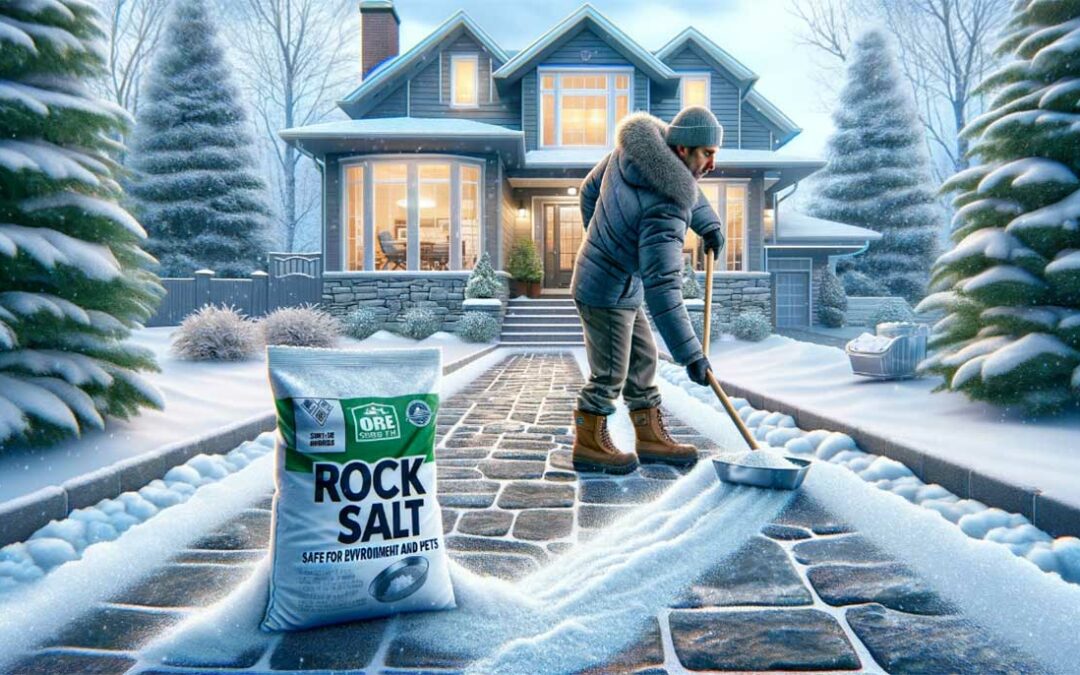It’s that time of the year again. Frozen water, slippery walkways, icy roads, and dangerous conditions are beginning.
When winter arrives, combating ice and snow buildup becomes a primary concern for homeowners, businesses, and municipalities. One of the most effective methods to address this is using rock salt. But not all rock salts are created equal. Some last longer than others, while some use relatively dangerous chemicals that should mostly be avoided. The best choice efficiently melts ice and snow and minimizes environmental impact and safety hazards.
Understanding Rock Salt and Its Alternatives

Using the Best Rock Salt to Prevent Ice Buildup
Rock salt, or halite, is the mineral form of sodium chloride. It works by lowering the freezing point of water, making it an effective de-icing agent. However, there are several types of de-icing salts and alternatives, each with its advantages and drawbacks. These include calcium chloride, magnesium chloride, potassium chloride, and eco-friendly blends.
Factors to Consider in Choosing Rock Salt
- Efficacy in Low Temperatures: Different salts work effectively at different temperature ranges. While regular rock salt is effective down to about 20°F (-6°C), calcium chloride can work in temperatures as low as -25°F (-32°C).
- Environmental Impact: Traditional rock salt can harm plant life, water sources, and wildlife. Eco-friendly alternatives or blends might offer a safer choice for those concerned about environmental sustainability.
- Corrosion and Property Damage: Some salts can be harsh on concrete, metal, and other materials. Choosing a product that minimizes the risk of damage to walkways, driveways, and vehicles is essential. Be sure to read the packaging of any rock salt you purchase carefully.
- Pet and Wildlife Safety: Regular rock salt can harm pets’ paws and local wildlife. Pet-safe and wildlife-friendly products are available and should be considered, especially in residential areas.
- Cost-Effectiveness: While some advanced or eco-friendly products may be more effective or safer, they can also be more expensive. Balancing efficacy and cost is crucial for practical and economical snow and ice management.
Best Practices for Using Rock Salt
- Timely Application: Applying rock salt before a snowstorm can prevent ice from bonding to the surface, making it easier to shovel snow later.
- Appropriate Quantity: Too much salt can increase environmental harm without improving efficacy. Follow the manufacturer’s guidelines for application rates.
- Proper Storage: Keep rock salt in a dry, covered area to prevent it from clumping and becoming ineffective.
- Combination with Other Methods: For best results, use rock salt in combination with snow shoveling and plowing. This integrated approach enhances safety and efficiency.
Letting Experts Handle Ice Management
As you can see, there is much to consider when choosing a rock sale. But this doesn’t even consider doing the work and laying the salt. This is and has always been dangerous and challenging to do well. The idea is to get outside before the ice forms, but that isn’t always possible with a busy schedule. Letting a qualified Ice Management Company in Rockland NY, handle this sort of thing will make a huge difference in getting it done right and without injury.
What to Think About
Choosing the suitable rock salt involves balancing effectiveness, environmental impact, safety, and cost. While traditional rock salt is widely used, exploring environmentally friendly and less corrosive alternatives can be beneficial. Regardless of the choice, proper application and combining de-icing with physical snow removal methods can significantly enhance winter safety and convenience. As with any chemical agent, responsible use is critical to maximizing benefits while minimizing harm.

